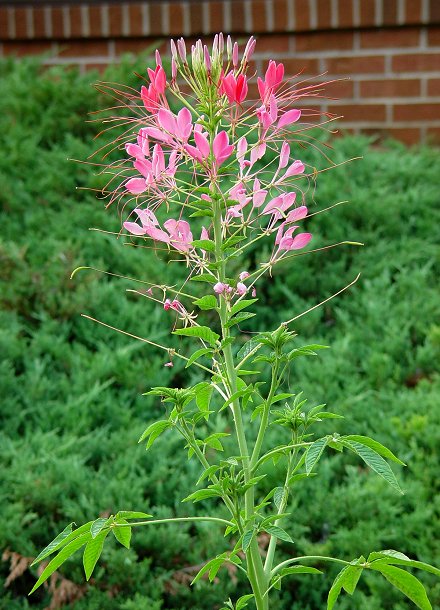Cleome hassleriana Chodat
Spider Flower

Introduced
CC = *
CW = 5
MOC = 13
© DETenaglia
Cleome hassleriana ChodatSpider Flower | |
 |
Introduced CC = * CW = 5 MOC = 13 |
© DETenaglia |
|
Family - Cleomaceae Habit - Annual taprooted forb. Stems - Erect, to 1.5 m, usually simple, densely glandular-hairy and with some appressed cobwebby pubescence above, with a prickly stipule at the base of each leaf petiole.
Leaves - Alternate, petiolate, palmately 5-7 compound. Stipules relatively stout golden brown spines 1-4 mm long. Petioles 6-15 cm long, adaxially grooved, hairy and glandular. Leaflets 3-10 cm long, 4 cm broad, oblanceolate to elliptic, acute to acuminate, tapered at base, entire or shallowly toothed, the upper surface glandular-pubescent, the lower surface sparsely pubescent and with prickles along the midrib. Petiolules to 4 mm long. Inflorescence - Dense terminal raceme to 35 cm long. Pedicels 4-6 cm long in flower, densely glandular, elongating in fruit. Bracts 1-4 cm long, 0.5-2.0 cm broad, simple, short-stalked to nearly sessile, ovate, cordate, tapered to a sharply pointed tip, densely glandular, with spines at base. Flowers - Sepals basally fused, 6-7 mm long, narrowly lanceolate, reflexed but with tips ascending, densely glandular and sometimes also sparsely hairy. Petals 4, all oriented to one side of the flower, similar in size and shape, 18-28 mm long, 6-8 mm wide, with a basal claw 6-12 mm long, pink to purple, rarely white. Glandular disc fleshy, conical, 1-3 mm long. Stamens 6, the filaments 3-4 cm long, the anthers 7-9 mm long, linear. Gynophore relatively short at flowering (0.5-0.9 cm) but elongating rapidly as the fruit matures to 3-8 cm long. Ovary green, 4 mm long, glabrous.
Fruits - Capsules 2-7 cm long, 3-4 mm wide, linear, 2-valved, with persistent stigma, usually slightly constricted between seeds, glabrous. Seeds numerous, 1.6-2.0 mm in diameter, the surface appearing wrinkled or warty, dark brown with lighter-colored warts and faint concentric lines. Placentation parietal. Flowering - August - October. Habitat - Cultivated, rarely escaping to roadsides, railroads, disturbed areas, streambanks. Origin - Native to South America. Lookalikes - Cleome serrulata; more broadly, Polanisia dodecandra. Note that many varieties and cultivars are commercially available and commonly found in gardens. Other info. - This plant is dubbed "Spider flower" because of the fanciful resemblance of the long stamens to spider legs. It is a fast growing species which is widely cultivated in Missouri, sporadically escaping cultivation but usually not persisting long. The plant produces many fruits and seeds and can be grown from seed. The flower color is typically pink or rose but red and white are not uncommon. Be careful when handling this plant as it is somewhat spiny. Photographs taken at the Kansas City Zoo, 6-4-00 and off Highway 23 near Gaylord, MI., 7-20-02. |